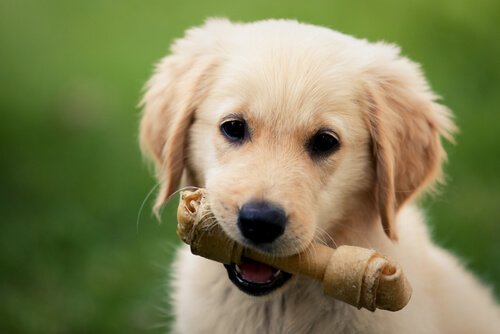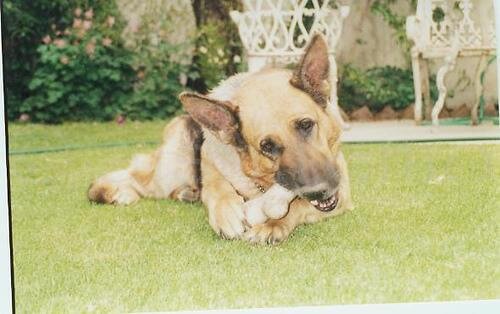How to Choose a Dog Dental Treat


Written and verified by the lawyer Francisco María García
Picking the right dog dental treat is important. Our pets, always faithful, affectionate companions, love treats — and if they’re good for their health too, even better!
Chewing and dental health
You can avoid the difficult task of brushing your dog’s teeth brushing yet still ensure good oral hygiene, fresh breath by giving your furry friend something called a “dog dental treat.” There are all kinds on the market now, including both natural and artificial dental chews. It’s very important to choose the right one for your particular dog.
You should understand that chewing is a natural behavior in dogs. In fact, a dog dental treat can basically act like a toothbrush, without the inconvenience that goes with teeth brushing.
Remember, too, that exercise, a proper diet and regular vet visits are needed for good oral hygiene. All of this helps prevent infection, tooth loss, and illness.
The risks of tartar and plaque buildup and gum disease increase when your dog turns three. According to the American Veterinary Dental Society, 80% of dogs that age have an oral health problem.
Food residue creates an ideal home for bacteria, turning teeth from white to yellow or brown and resulting in bad breath. Dental treats are designed to address these issues, exercise the dog’s jaw and relieve stress.

What to keep in mind when choosing a dog dental treat
There are several types of dental treats: some are made with natural horse and cow leather, others with veal or pork. The most important thing is check for quality, the supplier’s trustworthiness, and whether they meet veterinary norms for oral health.
Some treats have particular flavors, but it’s important to make sure they don’t contain harmful additives or hormones. Avoid ingredients like sodium nitrate, potassium sorbate, and artificial dyes.
To pick the right dog dental treat, watch how long it takes your dog takes to chew it. If he chews and swallows it in seconds, the product isn’t useful for teeth cleaning. In fact, it may cause choking. Treats that require more chewing are more effective.
Good quality chews have oral hygiene enzymes that keep plaque under control. They combine abrasive action with natural antiseptic activity, and some contain dietary fiber and natural sources of antioxidants.
Since they are treats, don’t give your dog too many, since they do contain calories. To be more precise, they should never exceed 10% of your dog’s daily diet.
Finally, consider your dog’s size and the condition of his teeth. For puppies, chew treats should be softer so that they don’t injure their gums. For adults, the hardness of the dog dental treat will help prevent damage, as long as it’s appropriate for the dog’s size.
Types of treats
-
Treats vary in consistency, flavor, shape and size. Some are soft, which is useful at an early age and while training, while others are dry and look like human food.

-
Be careful, since they can cause intestinal obstructions if swallowed. Therefore, get the right size for your dog.
-
Animal bones lead to tooth decay and problems in the gastrointestinal tract. The most dangerous are bird bones. Throw those away, because small, splintered bones can get stuck in your dog’s throat or puncture his intestines. Also, dogs love pig ears, but they can end in obesity.
-
Food meant for human consumption is also not recommended. For example, cookies, cheese and sausage are harmful. Carrots, lean meats, apples, poultry and shellfish, without sauces or spices, are good alternatives.
-
Other foods to avoid are onions, raisins and grapes; they are poisonous for pets. In addition, garlic should only be given under veterinary supervision.
-
Good options are artificial cartilage bones, knotted natural leather, plastic and beef.
Picking the right dog dental treat is important. Our pets, always faithful, affectionate companions, love treats — and if they’re good for their health too, even better!
Chewing and dental health
You can avoid the difficult task of brushing your dog’s teeth brushing yet still ensure good oral hygiene, fresh breath by giving your furry friend something called a “dog dental treat.” There are all kinds on the market now, including both natural and artificial dental chews. It’s very important to choose the right one for your particular dog.
You should understand that chewing is a natural behavior in dogs. In fact, a dog dental treat can basically act like a toothbrush, without the inconvenience that goes with teeth brushing.
Remember, too, that exercise, a proper diet and regular vet visits are needed for good oral hygiene. All of this helps prevent infection, tooth loss, and illness.
The risks of tartar and plaque buildup and gum disease increase when your dog turns three. According to the American Veterinary Dental Society, 80% of dogs that age have an oral health problem.
Food residue creates an ideal home for bacteria, turning teeth from white to yellow or brown and resulting in bad breath. Dental treats are designed to address these issues, exercise the dog’s jaw and relieve stress.

What to keep in mind when choosing a dog dental treat
There are several types of dental treats: some are made with natural horse and cow leather, others with veal or pork. The most important thing is check for quality, the supplier’s trustworthiness, and whether they meet veterinary norms for oral health.
Some treats have particular flavors, but it’s important to make sure they don’t contain harmful additives or hormones. Avoid ingredients like sodium nitrate, potassium sorbate, and artificial dyes.
To pick the right dog dental treat, watch how long it takes your dog takes to chew it. If he chews and swallows it in seconds, the product isn’t useful for teeth cleaning. In fact, it may cause choking. Treats that require more chewing are more effective.
Good quality chews have oral hygiene enzymes that keep plaque under control. They combine abrasive action with natural antiseptic activity, and some contain dietary fiber and natural sources of antioxidants.
Since they are treats, don’t give your dog too many, since they do contain calories. To be more precise, they should never exceed 10% of your dog’s daily diet.
Finally, consider your dog’s size and the condition of his teeth. For puppies, chew treats should be softer so that they don’t injure their gums. For adults, the hardness of the dog dental treat will help prevent damage, as long as it’s appropriate for the dog’s size.
Types of treats
-
Treats vary in consistency, flavor, shape and size. Some are soft, which is useful at an early age and while training, while others are dry and look like human food.

-
Be careful, since they can cause intestinal obstructions if swallowed. Therefore, get the right size for your dog.
-
Animal bones lead to tooth decay and problems in the gastrointestinal tract. The most dangerous are bird bones. Throw those away, because small, splintered bones can get stuck in your dog’s throat or puncture his intestines. Also, dogs love pig ears, but they can end in obesity.
-
Food meant for human consumption is also not recommended. For example, cookies, cheese and sausage are harmful. Carrots, lean meats, apples, poultry and shellfish, without sauces or spices, are good alternatives.
-
Other foods to avoid are onions, raisins and grapes; they are poisonous for pets. In addition, garlic should only be given under veterinary supervision.
-
Good options are artificial cartilage bones, knotted natural leather, plastic and beef.
This text is provided for informational purposes only and does not replace consultation with a professional. If in doubt, consult your specialist.







